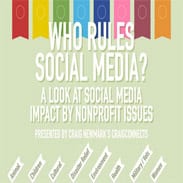Remember Me? I’m Your Customer.
You already know how to build your brand through social media marketing. You’re already on top of the changes that Facebook announced at the 2011 f8 Developers’ Conference. You’re also well-aware of the fact that you need to interact with your social media consumers, not just constantly pitch to them. As such, you’re always looking for ways to increase interaction and dialogue with Facebook fans.
You follow all the social media rules of engagement because you want to build your social brand. That’s fine – building your social brand is your job. However, have you ever stopped to ask yourself what’s in it for your fans and followers? You know what you’re getting out of your social media relationship with them; what are they getting out of it?
The better you understand what your social media followers are getting from their relationship to your brand, the better and faster you will be able to build your social brand. Let’s have a little Being John Malkovich moment and travel inside your followers’ heads.
1. Social media consumers want to save money
One of the greatest perks to social media consumers is the ability they gain to find deals and save money. They are no longer chained to whatever they can find at their local retail stores; unfettered, they prowl Facebook pages and join email lists with the intention to save a couple bucks on products they like or think they might like.
Here are some social media statistics you need to know:
- 88% of women and 70% of men say that promotions were what motivated them to subscribe to emails from a company (Source: InternetRetailer.com)
- 40% of consumers who “Like” a Facebook page do so in the hopes that they will receive discounts; this is the top reason they click “Like” (Source: SocialMediaExaminer.com)
- Another 36% of consumers say they follow Facebook business pages to get a freebie or coupon (Source: SocialMediaExaminer.com)
- Put the two above statistics together and you’ll see that 76% of Facebook fans are hoping to get a deal of some kind
- 43.5% of Twitter users start following a brand in the hopes of deals and discounts; this is also the number one reason for following a Twitter user (Source: GetSatisfaction.com Blog)
- 70% of social media users who follow brands report that they have participated in a sweepstakes or other brand-sponsored contest (Source: GetSatisfaction.com Blog)
2. Social media consumers want to display their personality
Interestingly enough, the same social media study that found the #1 reason for following a brand is the somewhat predictable wish to save money found that the #2 reason for following a brand is to publicly display their brand affiliation. Receiving discounts was the top reason for 40% of respondents; showing support for a brand was the top reason for 39% (Source: SocialMediaExaminer.com).
In other words, Facebook users will frequently “Like” a page simply for the purpose of self-expression. Understanding this, you may wish to think more about what following your page says about a person and how you can tweak that meaning to reach out via social media to more people and the right people.
3. Social media consumers want to be entertained
While people use a site like Google principally to find information, people are often using sites like Facebook, YouTube, and Twitter for the same reasons that they turn on the television: They want to be entertained.
As part of their drive to be entertained, Facebook users continue to consume Facebook apps at a rapid rate. Facebook’s own statistics state that “more than 500 million people use an app on Facebook or experience Facebook Platform on other websites” each month (Source: Facebook.com).
Facebook games continue to blow the minds of their creators. Data from September 2010 reveals this about Facebook games:
- 53% of all Facebook users play social games, or 56 million each day
- Unlike the typical gamer profile, these gamers are 69% women
- 50% of all Facebook logins are for game playing
- The average gamer plays for 210 minutes each month
(Source: AllFacebook.com)
4. Social media influencers have their own agenda
Much has been written about creating “brand evangelists” — influential bloggers and consumers who will build your brand for you just because they like you so darn much. However, it’s important not to be sucked in to the evangelism about brand evangelists. Don’t be naïve; most of these influencers review, write about, and promote your brand and products as part of building their own brand.
Independent reviewers and bloggers are mostly interested in building their own fan base and sphere of influence. When you reach out to an influencer, you must remember that their agenda is just as self-promoting as yours is. Therefore, ask yourself how your brand can benefit the influencer before reaching out and suggesting a collaboration.
Now that you’ve gotten a glimpse of what’s going on inside your followers’ minds, reexamine your social media outlets and check to see if you are actually meeting their needs. You might be great at posting surveys and responding to comments right away, but have you really taken the time to consider why your social media fans are following you in the first place? Once you align the content you provide with the reasons consumers follow your brand, your social media success will skyrocket.
Don’t know why your existing fans are following you? Here’s a novel approach: Ask them.
Return to top: Social Media Brand Engagement: What’s in it for the Consumer?
Have some thoughts on this topic or general comments? Share them below.


























